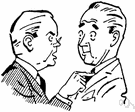jaun·dice
(jôn′dĭs, jän′-)n.
1. Yellowish discoloration of the whites of the eyes, skin, and mucous membranes caused by deposition of bile salts in these tissues. It occurs as a symptom of various diseases, such as hepatitis, that affect the processing of bile. Also called icterus.
2. A state or feeling of negativity or bitterness arising especially from envy or world-weariness.
tr.v. jaun·diced, jaun·dic·ing, jaun·dic·es
1. To affect with the discoloration of jaundice.
2. To affect with the negativity or bitterness of jaundice. See Synonyms at bias.
[Middle English jaundis, jaunis, from Old French jaunice, yellowness, jaundice, from jaune, jalne, yellow, from Latin galbinus, yellowish.]
American Heritage® Dictionary of the English Language, Fifth Edition. Copyright © 2016 by Houghton Mifflin Harcourt Publishing Company. Published by Houghton Mifflin Harcourt Publishing Company. All rights reserved.
jaundice
(ˈdʒɔːndɪs)n
1. (Pathology) Also called: icterus yellowing of the skin and whites of the eyes due to the abnormal presence of bile pigments in the blood, as in hepatitis
2. a mental state of bitterness, jealousy, and ill humour resulting in distorted judgment
vb
3. to distort (the judgment, etc) adversely: jealousy had jaundiced his mind.
4. (Pathology) to affect with or as if with jaundice
[C14: from Old French jaunisse, from jaune yellow, from Latin galbinus yellowish, from galbus]
ˈjaundiced adj
Collins English Dictionary – Complete and Unabridged, 12th Edition 2014 © HarperCollins Publishers 1991, 1994, 1998, 2000, 2003, 2006, 2007, 2009, 2011, 2014
jaun•dice
(ˈdʒɔn dɪs, ˈdʒɑn-)n., v. -diced, -dic•ing. n.
1. Also called icterus. yellow discoloration of the skin, whites of the eyes, etc., due to an increase of bile pigments in the blood.
2. a state of feeling in which views are prejudiced or judgment is distorted, as by envy or resentment.
v.t. 3. to distort or prejudice, as by resentment or envy.
[1275–1325; Middle English jaundis < Old French jaunisse=jaune yellow (< Latin galbinus greenish yellow) + -isse -ice]
Random House Kernerman Webster's College Dictionary, © 2010 K Dictionaries Ltd. Copyright 2005, 1997, 1991 by Random House, Inc. All rights reserved.
jaun·dice
(jôn′dĭs) Yellowish discoloration, as of the skin and whites of the eyes, that is a symptom of diseases like hepatitis that interfere with the normal processing of bile.
The American Heritage® Student Science Dictionary, Second Edition. Copyright © 2014 by Houghton Mifflin Harcourt Publishing Company. Published by Houghton Mifflin Harcourt Publishing Company. All rights reserved.
jaundice
a disease of the liver, characterized by, among other symptoms, yellowness of the skin. Also called icterus.
See also: Complexion-Ologies & -Isms. Copyright 2008 The Gale Group, Inc. All rights reserved.
jaundice
Past participle: jaundiced
Gerund: jaundicing
| Imperative |
|---|
| jaundice |
| jaundice |
Collins English Verb Tables © HarperCollins Publishers 2011
jaundice
Accumulation of bile pigment in the blood leading to yellowing of body tissues, including the skin and the whites of the eyes. Jaundice is an indication of many liver and bile disorders, including blocked bile or hepatic ducts.
Dictionary of Unfamiliar Words by Diagram Group Copyright © 2008 by Diagram Visual Information Limited
ThesaurusAntonymsRelated WordsSynonymsLegend:
| Noun | 1. |  jaundice - yellowing of the skin and the whites of the eyes caused by an accumulation of bile pigment (bilirubin) in the blood; can be a symptom of gallstones or liver infection or anemia jaundice - yellowing of the skin and the whites of the eyes caused by an accumulation of bile pigment (bilirubin) in the blood; can be a symptom of gallstones or liver infection or anemiasymptom - (medicine) any sensation or change in bodily function that is experienced by a patient and is associated with a particular disease hyperbilirubinemia - abnormally high amounts of bile pigment (bilirubin) in the blood icterus neonatorum, jaundice of the newborn, physiological jaundice of the newborn - yellowish appearance in newborn infants; usually subsides spontaneously kernicterus - an abnormal accumulation of bile pigment in the brain and other nerve tissue; causes yellow staining and tissue damage |
| 2. |  jaundice - a rough and bitter manner jaundice - a rough and bitter manner disagreeableness - an ill-tempered and offensive disposition | |
| Verb | 1. | jaundice - distort adversely; "Jealousy had jaundiced his judgment" |
| 2. | jaundice - affect with, or as if with, jaundice affect - act physically on; have an effect upon; "the medicine affects my heart rate" |
Based on WordNet 3.0, Farlex clipart collection. © 2003-2012 Princeton University, Farlex Inc.
jaundice
verbTo cause to have a prejudiced view:
The American Heritage® Roget's Thesaurus. Copyright © 2013, 2014 by Houghton Mifflin Harcourt Publishing Company. Published by Houghton Mifflin Harcourt Publishing Company. All rights reserved.
Translations
يَرْقَانٌيَرَقان، صَفار
žloutenka
gulsot
GelbsuchtIkterus
keltatautiikteruskeltaisuus
žutica
gula
黄疸
황달
geltligė
dzeltenā kaite
žltačka
gulsot
โรคดีซ่าน
bệnh vàng da
Collins Spanish Dictionary - Complete and Unabridged 8th Edition 2005 © William Collins Sons & Co. Ltd. 1971, 1988 © HarperCollins Publishers 1992, 1993, 1996, 1997, 2000, 2003, 2005
Collins English/French Electronic Resource. © HarperCollins Publishers 2005
jaundice
n → Gelbsucht f
Collins German Dictionary – Complete and Unabridged 7th Edition 2005. © William Collins Sons & Co. Ltd. 1980 © HarperCollins Publishers 1991, 1997, 1999, 2004, 2005, 2007
Collins Italian Dictionary 1st Edition © HarperCollins Publishers 1995
jaundice
(ˈdʒoːndis) noun a diseased state of the body in which the skin and whites of the eyes become yellow.
Kernerman English Multilingual Dictionary © 2006-2013 K Dictionaries Ltd.
jaundice
→ يَرْقَانٌ žloutenka gulsot Gelbsucht ίκτερος ictericia keltatauti jaunisse žutica itterizia 黄疸 황달 geelzucht gulsott żółtaczka icterícia желтуха gulsot โรคดีซ่าน sarılık bệnh vàng da 黄疸Multilingual Translator © HarperCollins Publishers 2009
jaun·dice
n. ictericia, derrame biliar por exceso de bilirrubina en la sangre que causa pigmentación amarillo-anaranjada de la piel y otros tejidos y fluidos del cuerpo;
obstructive ___ → ___ obstructiva, obstrucción de la bilis.
V.: icterus. English-Spanish Medical Dictionary © Farlex 2012
jaundice
n ictericia (form), coloración amarilla de la piel y los ojosEnglish-Spanish/Spanish-English Medical Dictionary Copyright © 2006 by The McGraw-Hill Companies, Inc. All rights reserved.